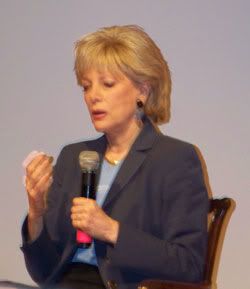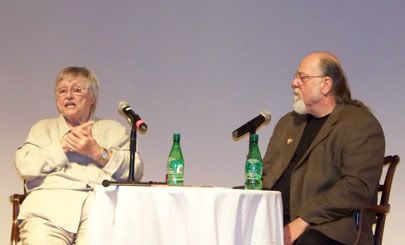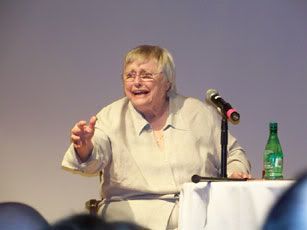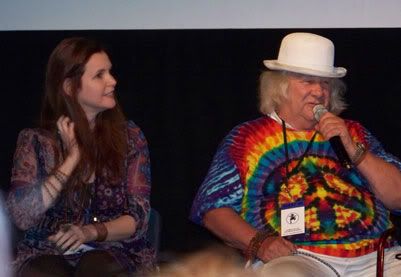A Conversation With Lesley Stahl @ The High Falls International Film Festival, 5/16/09
Saturday, May 16th, 2009 at 9:30 am
Memorial Art Gallery, Rochester, New YorkFeaturing:
Catherine Wyler, Artistic Director, High Falls International Film Festival
Lesley Stahl, Correspondent, CBS News, 60 Minutes

Lesley Stahl (Right) with Catherine Wyler
The friendship of High Falls' Artistic Director Catherine Wyler and Lesley Stahl stretches back decades. Wyler and Stahl were part of a group that met once a month for lunch while living in Washington, DC; the group fell apart after Stahl moved to New York. Over the years, Wyler and Stahl stayed in touch, with Wyler attending the wedding of Stahl's daughter, Taylor, and Stahl being a member of High Falls' Board of Directors. Stahl was scheduled to be at last year's festival until Stahl had to be whisked away to Iran at the last minute.
Catherine Wyler read the opening line of Stahl's 1999 autobiography, Reporting Live: "I was born on my 30th Birthday." Stahl elaborated on that statement, stating, "My career didn't really start until I was 30. The thing with young people is that sometimes they don't know what they want out of life, and I didn't find out until I was 30. [Turning 30] really changed me."
Pushed by her mother to "have a career, not a job", Stahl attended Wheaton College. "A lot of mothers in the 1950s became housewives--it was sort of the ethic then. Betty Friedan wrote about it in The Feminine Mystique. My mother was very frustrated at home. Even before Betty Friedan's book, my mother, when I was in college, told me that I needed to have a career, and that she 'wasn't going to stand for a job'. She wanted a profession out of me." Stahl's mother was willing to support her in whatever field she wanted, so as long as it was something she wasn't going to quit.
Still, journalism wasn't necessarily on young Lesley's agenda; she says that she never worked for any school newspaper. It wasn't until she was working as an assistant to the speechwriter in the Mayor of New York City's office that she decided to become a reporter. One day, she approached a reporter and asked him, "What do you do all day? You wake up, and what happens? " He described his duties, and according to Stahl, "It was like a lightbulb had gone off in my head. I thought, 'I have to do that.'
A few years later, Stahl was working at a TV station in Boston when she heard from CBS News: a memo stated that the next three correspondents hired by the network would be either women or minorities. She said to her fellow producer, "Can you make me a reporter really fast?" Lesley and the producer set about putting together an hour and a half long demo reel, only to be told that most demo reels were only about 20 minutes. In 1972, she was hired along with Connie Chung and Bernard Shaw to be a correspondent for CBS News. Stahl considers herself to be a direct beneficiary of Affirmative Action.
"The first White House I corresponded for were Democrats. They were pro-ERA, and they didn't treat women very well. In comes the Reagan Administration, against the Equal Rights Amendment. All of Reagan's people treated [women] professionally. In the Reagan White House, I was treated like a professional, not a woman."
Wyler brought up a passage from Reporting Live that discussed speculation that Reagan may have already been afflicted with Alzheimer's Disease when he ran for re-election in 1984.
"When a President begins to fail, there a couple of things that come into play," Stahl said. The Wall Street Journal published a piece that noted that Reagan, while debating with Walter Mondale, was "wandering all over the place". While Stahl doesn't insist that Reagan had Alzheimer's then, she spoke with an Alzheimer's specialist, who told her that Alzheimer's "Is a gradual disease. When it starts, there are periods of great lucidity, and then all of a sudden, in the middle of the day, in the middle of the week, something's wrong, something's not there, then it hits. People who are having problems try to hide it."
During Reagan's second term, Stahl believes that Nancy Reagan's had more influence and support, and suggested that if Reagan did indeed have an illness, Nancy may have even guarded that secret from the staff. "We'll never know, because she'll never tell." Stahl recently interviewed Nancy Reagan for WowOWow (more about that later), and CBS' Sunday Morning in promotion for a new book by their daughter, Patti:
Watch CBS Videos Online
Stahl emphasized the continuing importance of the media as part of maintaining a democracy. She noted that in countries where press is not free, the Governments have corruption. "When we have corruption, the press calls corruption out." Stahl lamented the current problems Newspapers are facing, but added that this is all part of the system "cleansing itself".
Last year, Stahl added "entrepreneur" to her resume, launching WowOWow.com with Joni Evans, Liz Smith, Mary Wells Lawrence, and Peggy Noonan. WowOWow is targeted at women over 40 with an emphasis on Politics, Fashion, Foreign Policy, and Gossip, among other things.
"I always wanted to own something," Stahl stated, and added that "like Newspapers, we're struggling with ad revenue, and I hope we find a good model, whatever that's going to be."

Q: In what way do First Ladies put their stamp on the White House?
Stahl: I think we would be surprised to find out how important First Ladies are. Presidents become skeptical during their time in the White House of who they can trust. They have to create inner circles that allow them to say what they think, and let their hair down. Today, with blogging and the internet, they have become even more aware. As their circle shrinks, who's left? They go home at night, and probably discuss everything in their lives. Of course, their wives have been partners in their public life.
Most Presidential Marriages get better in the White House. Up until then, the Public isn't around all the time. They travel a lot, they have wives greet people [at the White House]. The wife, 24 hours a day, is a confidante. So the marriage gets stronger, they are together as the President comes home at night.
Q: How do you think Hilary Clinton is doing as Secretary of State?
Stahl: I interviewed her as well [for the Joe Biden interview]. She and Joe Biden have breakfast together every Tuesday. It's part of the Team of Rivals, to make sure that they all get along. My sense from what I got from interviewing her that day was that she was really liking this job. And that was the big question: "Would she really enjoy this?" She wasn't the most powerful senator, but she was certainly the most famous one. I get the sense that the job is another challenge for her. Her specialty as a Senator wasn't Foreign Policy, but she finds the work challenging, and she's really enjoying it.
Q: I'm curious. Do you consider yourself a Feminist?
Stahl: I was working when the Women's movement was really, really powerful. When Gloria Steinem, Betty Friedan, Bella Azbug, were marching, I knew that they were helping me. I knew that I'd gotten to CBS News through Affirmative Action, and I knew that I would be getting equal pay because of them. I was not a feminist in the political sense, because I wanted to achieve that through my abilities. But in my heart, I was a feminist.
(Addressing the questioner, a young woman) Women your age don't like the word feminist, don't want to be called feminist. My daughter doesn't like the word, but when you sit down and talk with them about the struggles and the changes that happened in the '70s, what they were fighting for, and they admire that. Somewhere along the way, the word "feminist" got a negative reputation.
Q: I was watching a TV show several years ago that was a roundtable of women journalists, and they were all talking about their experiences in the business. They were going around the table, and going on and on about, "Oh, it was so terrible, they way me treated us," and it came to you and you said, "Gee, I didn't have those problems. It wasn't that way for me." And they all looked at you like they didn't know what to say. What made your experience different from theirs?
Stahl: Well, for one thing, the attitude. When I was hired, and as Connie was saying [in the roundtable]--we were hired together--I knew the man who hired me wanted me to succeed. He was invested in me coming up. And all the men who were my colleagues also wanted me to succeed. I didn't feel that anyone was trying to sabotage me, unlike my peers. The cameramen were really hard for me to work with, but my eye wasn't there. My eye was on my boss, and doing my job as a reporter. And if I didn't do well, I never allowed myself to fail, never blamed on being a woman. I just felt in my heart that they system would help me as long as I did well. And if I heard someone say something a little off color, I ignored it, and moved on.
Labels: 60 Minutes, Catherine Wyler, CBS News, Connie Chung, High Falls Film Festival, Hilary Clinton, Joe Biden, Lesley Stahl, Nancy Reagan, Rochester, Ronald Reagan, wowowow.com







